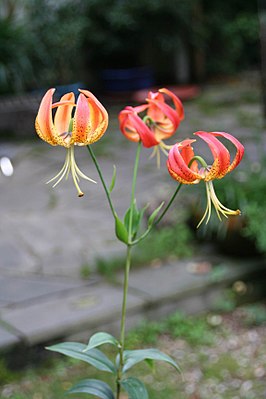Lilium pyrophilum
| Lilium pyrophilum | ||||||||||||
|---|---|---|---|---|---|---|---|---|---|---|---|---|

Lilium pyrophilum |
||||||||||||
| Systematics | ||||||||||||
|
||||||||||||
| Scientific name | ||||||||||||
| Lilium pyrophilum | ||||||||||||
| MWSkinner & Sorrie |
Lilium pyrophilum MW Skinner & Sorrie is a species of the genus of lilies ( Lilium ) in the American section .
description
The onion of Lilium pyrophilum forms unusually wide, branched rhizomes . The plant blooms in late summer from a stem up to 90 centimeters high with short, narrow leaves in one to three whorls in the lower half, but alternate in the upper half.
The flower is orange to yellow-orange, dotted dark red and shaped like a Turk's collar . The seed germinates with a delay - epigeously , the plant reproduces vegetatively through its rhizome.
Distribution and ecology
The plant is one of the rarest species of lily, only about 250 individuals are known. Their occurrences are mainly in the Sandhills region of eastern North Carolina , including on the military area of Fort Bragg , individual finds have also been reported from South Carolina and southeastern Virginia . The populations are allopatric , that is, geographically so isolated from one another that there is no longer any genetic exchange between them.
Lilium pyrophilum preferred full sunny places in marshes with sandy soils in Stream Head pocosins and Sandhill sweeps as companies, among others, pitcher plants and bog pines . In this ecosystem there are regular fires, which act as a kind of natural mowing and thus ensure the survival of the lily. Lilium pyrophilum benefits from the nutrients found in the ashes and the opening of the plant cover by the regular fire.
Systematics and botanical history
Lilium pyrophilum is a close relative of Lilium superbum .
It had been known in isolated cases since the 1940s, but was not assessed as a separate species. Originally it was assumed that it was a variety of Lilium iridollae , later it was also assessed as Lilium superbum or Lilium michauxii .
It was not until the mid- 1990s that Lilium pyrophilum was recognized as a species in its own right as part of a research contract to finally clarify the taxonomic status of Lilium pyrophilum ; it was first described in 2002 by Mark W. Skinner and Bruce A. Sorrie.
Their name pyrophilum ( Latin : fire-loving) comes from their preference for habitats that are regularly affected by forest fires.
Due to its rarity and the threat of habitat destruction (especially construction work), the plant was proposed for full protection status at the same time as its description.
At the beginning of 2006 approx. 250 plants from artificial propagation were put on sale, since then the plant has been in culture, but since all of them were clonally propagated and are self-sterile, survival in culture is not guaranteed.
swell
- Mark W. Skinner, Bruce A. Sorrie: Conservation and Ecology of Lilium pyrophilum, a New Species of Liliaceae from the Sandhills Region of the Carolinas and Virginia, USA , in: Novon: A Journal for Botanical Nomenclature: Vol. 12, No. 1, 2002, pp. 94-105.